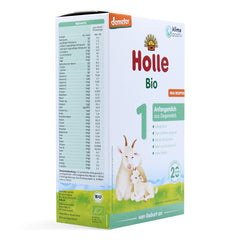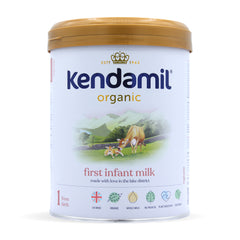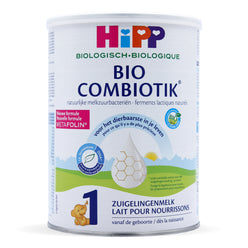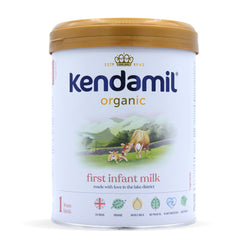How To Switch Baby's Formula
72 hours of research 5 minute read

By the time a baby enters its first year of life, they have likely drank hundreds of bottles of baby milk. Whether it is consumed on its own or in combination with breast milk, you may not always be able to feed the same formula to your baby.
Switching between different baby formulas may not only vary from parent to parent but also from baby to baby. The reasons for this may include the cost of formula, formula ingredients, or even the texture of a baby formula. This article focuses on the steps you should take when deciding to switch your baby's formula safely and if that is something you are looking for, keep reading on!
Is It Okay To Switch Baby Formulas?
Parents may switch baby formulas if they feel like there is another formula better suited for their child's needs. However, if you are unsure if the formula you are switching to may be better or worse for your baby, it is better to stick to the formula they are currently using and consult a physician. It is highly advised to choose a baby formula according to the health professional's recommendations and never to test a promotional sample or a formula offering an incentive for the baby.
When Should You Consider Switching Baby Formulas
The situation that may prompt the parent to change their baby's formula include allergies, lactose intolerance, and inadequate nutritional value.
- The baby might have an allergy to some of the content of the baby formula, which may present itself with several symptoms. These may include dark patches on the skin, forceful vomiting, or extreme weakness and fatigue. These symptoms may indicate that the baby's body is rejecting the formula, and they may not be getting all the nutrients they require for growing up. Babies with an allergy to the previous baby formula may also often be fussier than they usually are.
- The doctor may also suggest a parent switch their baby's formula because the baby may be lactose intolerant and may require a formula that is better suited for them.
- A baby who requires extra nutrients for their growth may require a special formula that matches their needs. An example of this is a baby who requires a higher iron. Therefore, taking an iron-fortified baby formula may be recommended to help with their growth and body functions.
Popular Baby Formulas Most Parents Switch To
When switching your baby's formula, the choices can seem overwhelming but it's essential to consult with your pediatrician to ensure a smooth transition and address any specific concerns or dietary needs your baby may have. Transitioning to these popular baby formulas renowned for their quality ingredients and gentle formulations - HiPP Dutch, Holle Goat Dutch, and Kendamil Organic - can be done smoothly and confidently, ensuring your baby gets the best possible start.
✓ 100% Organic Formula
✓ With Added Prebiotics and Probiotics Ideal for Babies Transitioning Formulas
✓ HiPP's most popular formula
Check PricePopular With Parents Because: When it comes to baby formulas most parents choose to switch to, HiPP Dutch stands out for its exceptional quality and dedication to providing optimal nutrition. Packed with added prebiotics, probiotics, and immune-boosting galacto-oligosaccharides sourced from organic lactic acid bacteria cultures, it mirrors the benefits of natural breast milk, making it a top choice for parents transitioning their little ones to a new formula.
✓ Demeter Certified (Organic++)
✓ Easy-to-digest Goat Milk Formula Suited for a Smooth Switch
✓ Popular for babies with sensitivity to cow's milk
Check PricePopular With Parents Because: For babies with cow's milk sensitivities, Holle Goat Dutch offers a gentle alternative that's easy to digest. Made from organic whole goat's milk, it closely mirrors the protein composition found in breast milk. This ensures your baby receives vital nourishment while ensuring a smooth transition when switching from another formula.
✓ Vegetarian-friendly (Contains Plant-Based DHA and ARA)
✓ Contains Milk Fat Globule Membrane (MFGM)
✓ EU and British Soil Association Certified Organic
Check PricePopular With Parents Because: When switching baby formulas, Kendamil Organic emerges as a top contender. Parents love it for its wholesome, organic ingredients and sustainable practices. Its gentle formula, free from palm oil and GMOs, ensures a smooth transition for your little one. By exclusively using cow's whole milk, it creates a lactose-based infant formula that closely mimics natural breast milk, providing the familiar nourishment babies need during this transition period.
Steps To Take When Switching A Baby Formula
Consulting A Pediatrician
Consulting a pediatrician when thinking of switching the baby's formula milk is highly recommended. This may not only include the time when you are thinking of switching due to health conditions or nutritional reasons, but it also includes financial causes. After a health assessment of the baby and taking a detailed history from the parents, the doctor may be able to recommend a baby formula that will suit the baby the best.
For example, if the baby seems deficient in their growth rate and looks like they are not getting enough iron, they may be recommended a fortified iron formula. If the parents complain of the baby having severe acid reflux that interferes with their diet patterns, they may be recommended formulas specially designed for such babies.
Study The Different Forms of Formula Milks
After the doctor has recommended the type of formula milk which may be ideal for the baby, it is up to the parents to be extra careful while purchasing the milk. This includes varying the brand and their background. They may also read the label on the milk carefully and all the substances added to it.

For example, if a baby took formula milk that contained DHA and iron and was not causing them any discomfort, the new formula milk should also contain these substances. Reading the label will also help the parents be sure that the new formula does not contain any substances that were causing the baby discomfort or hypersensitivity in the previous formula.
Test The New Baby Formula
Before completely switching to the new formula, the doctors usually advise the parents to start testing it on the baby. This may be done by giving a little amount and evaluating the baby's response to it. If they are comfortable with it and don't react negatively, the new formula may be safe for them. However, if the baby starts crying or fusses about taking the new formula, you may wait a few minutes before trying again. If this does not work, you may consult an expert in order to help you determine why the baby might not be trying the new formula.
Gradual Transition
Once the parent has tested the new formula on the baby and is sure it is safe for the baby, they may start the process of gradual transmission. This may be done by adding 1/4th of the new formula to the preparation medium while keeping 3/4th of the old formula. This mixture can be fed to the baby to introduce them to the new taste.
The next day, the composition of the new formula may be increased to half while keeping half of the old formula. This will allow the baby to taste the new formula better and make them even more used to it. Day by day, this ratio of new to old formula may be increased until the new replaces the old completely. By this time, the new baby formula will not surprise the baby as they have been tasting it throughout the previous week.
Check How The Baby is Reacting to The New Formula
After the baby has been successfully switched to the new formula, they must be observed as not all reactions are immediate, and some may display their signs with time. The health parameters that may be given special attention as a baby start a new formula include:
- Their Weight: It is ideal to check the baby's weight every day and compare the results after starting the new formula. If the weight gradually increases, the baby can get the nutrients from the new formula and maybe be in good health. However, if the baby has not gained weight ever since the start of the formula or appears to be losing weight, a health professional should be immediately consulted.
-
The Digestive System: If a new formula is causing an allergic response in the body, or the baby's digestive system cannot absorb its constituents, they may present with signs like vomiting, diarrhea, excessive gassiness, and even constipation. It is also important to differentiate between signs of the digestive system that are normal in a baby and the ones which may be considered worrisome.
For example, while occasional and temporary gassiness and irritation after drinking milk may be considered normal, if this happens every time they take their milk and become chronic – the individual should consult a physician. - Signs of Allergic Reaction: If your baby presents with a sign like rashes, hives, or redness all over their body after consuming the formula milk, the milk should immediately be stopped, and medical attention should be sought. These are signs of an allergic reaction, which is not something to be taken lightly and requires immediate treatment.
Things To Keep In Mind While Starting A New Baby Formula

- When buying a baby formula at the store, it is essential to take note of the expiration date. If the formula is ordered online, you may look for the expiration date before opening the packaging once it has been delivered home.
- When buying baby formula online, it is always advisable to buy it from a known retailer who you or someone you knew has purchased from earlier and has a good experience. Never give a milk formula to a baby who has unsealed packaging or looks like it has been resealed.
- The mixing ratio can make a big difference in the baby milk's final appearance and nutritional value. Adding too much or too little water may change the taste of the formula, which the baby may not like, and they may refuse to consume it. More water may also reduce the number of calories and nutrients that are being delivered to the baby, which may, in turn, have an impact on their health and growth.
How to Switch Baby Formula
There are a number of reasons why a parent may decide to switch their baby's formula milk. This is irrespective of whether they are feeding their baby completely on formula milk or giving it in combination with breastfeeding. It is advisable to consult a physician while switching to a new formula and make sure the content included in it is according to the baby's specific needs. Once the doctor agrees on the formula, the parents may start by slowly incorporating it into the baby's diet, allowing them to accept the new formula better.
For those wondering how to switch formula, it's crucial to follow your pediatrician's guidance throughout the transition, as they can provide personalized advice based on your baby's unique needs. Similarly, when transitioning from formula to milk, adopt a gradual process by introducing small amounts of milk into your baby's diet while continuing with their formula. Gradually increase the milk ratio as recommended by your healthcare provider for a smooth transition tailored to your child's well-being. Remember, each baby is different, so consulting with your doctor ensures the best approach for your little one.
3 Most Popular Baby Formulas
Organic Life Start is committed to providing accurate, reliable, and trustworthy information to parents and caregivers. We carefully choose credible sources and follow a meticulous fact-checking process to uphold the highest standards in infant nutrition and parenting advice. To learn more about our dedication to accuracy, please explore our editorial guidelines.
Link To Sources
- https://www.babycenter.com/baby/formula-feeding/can-i-switch-formula-brands-and-if-so-how-do-i-ease-the-tran_1334521
- https://www.parents.com/baby/feeding/formula/how-to-switch-baby-formula-brands/
- https://us.kendamil.com/blogs/blog/introducing-new-formula-to-baby-tips-for-a-smooth-formula-transition#:~:text=Best%20way%20to%20switch%20baby,chart%20to%20explain%20this%20better:
- https://health.clevelandclinic.org/transition-from-formula-to-milk
- https://www.hipp.nl/melk/geitenmelk/














Wilder W -
As a mom, I really appreciated this guide! I remember how nervous I was when we had to switch formulas due to my baby’s eczema and tummy troubles. The gradual switch method worked wonders for us, and I’m glad this blog explains it so clearly. Thanks for making a confusing process feel a lot easier!
Ember H -
I’ve always wondered how to tell if my baby’s fussiness after feedings was just a phase or if it meant something was off with the formula. As a first-time mom, it’s so hard to know what’s “normal” and when to ask for help. 😞 My little one was gassy and had trouble sleeping, and I kept second-guessing myself for weeks.
Eventually, I talked to our pediatrician and they suggested trying a different formula. I was nervous at first, but we made the switch slowly—just a little at a time—and it actually made a big difference. She’s way more settled now and seems so much more comfortable after feeds. This blog really helped me understand that switching formulas isn’t something to be afraid of, especially when it’s done with the doctor’s guidance. Every baby is different, and sometimes just making a gentle change can bring so much relief—for baby and mom both!
Kiara B -
My baby struggles with digestive issues, and regular cow milk does not seem to be working because she regularly gets gas and constipation. I am considering HA and goat formulas, but I do not know which is a better fit. Switching formulas is scary because I do not know how my baby will react to the formula. It is also expensive because, well, it’s a waste if she does not like it. I just want to be sure so all your inputs will help!